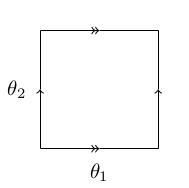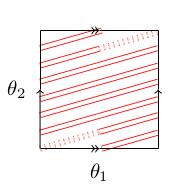Any compact matrix group contains a compact abelian matrix group which is (a) path-connected and (b) nontrivial.
Optional: Finding compact abelian subgroups
Compact abelian subgroups exist
This video is optional.
In the next video, we'll see that any compact, path-connected abelian group is a torus, so together these results will show that contains a nontrivial torus.
Let be a nontrivial abelian subalgebra, that is a subspace of on which the commutator bracket vanishes.
Note that there is always a nontrivial abelian subalgebra if is nontrivial, for example a line in is a nontrivial abelian subalgebra: suppose we look at the line spanned by , then any two elements and of this line commute with one another.
We now make two claims:
-
is an abelian subgroup of .
-
while is not necessarily compact, its topological closure is a compact abelian subgroup.
Together, these claims will prove the proposition (we just need to take the path-component of the identity in ).
To prove claim 1, we observe that for all because and commute. This implies that is a subgroup of , because if and then and because is a subspace.
Moreover, is abelian, because:
To prove claim 2, we showed earlier (as an exercise) that the topological closure of a subgroup is a subgroup, so we just need to show that is compact and abelian. The fact that it's compact follows from the fact that it's closed (by construction) and contained in a compact set (the compact group ), and it's a general fact from point-set topology that a closed subset of a compact set is compact. (This is clear for us because "compact" means "closed and bounded", and a subset of a bounded set is bounded).
So the key thing to check is that is abelian. This follows from the next lemma below.
Note that it's not always true that exp of a Lie subalgebra gives a subgroup of .
If is an abelian subgroup then its topological closure is abelian.
consists of limit points of sequences in which converge in . Suppose I have sequences and with , . Since is abelian, we have This implies that so it's enough to show that
This follows from the fact that matrix multiplication is continuous. Let be matrix multiplication, i.e. . This is continuous: it's actually a polynomial in the matrix entries. Therefore (you can "bring limits inside" continuous functions). This means exactly that as required.
The proposition now follows by taking the path-component of the identity inside .
Example
The following example should illustrate why I went to the bother of taking the topological closure and what it buys for us.
Let be the 2-dimensional torus . We can draw it as a square with its opposite sides identified (the square lives in the -plane, and the side-identifications correspond to when or cross over a multiple of and restart from zero.

On the square, a 1-parameter subgroup of will look like a bunch of straight line segments with the property that when one of the segments "leaves the square", another one re-enters the square at the opposite point (with the same slope).
Remember that a 1-parameter subgroup is precisely exp of a line in the Lie algebra. Pick a 1-parameter subgroup corresponding to a line of irrational slope. This will wrap around infinitely often in the group : in fact, it is dense in (comes arbitrarily close to any given point). The topological closure of this subgroup is then the whole of .
